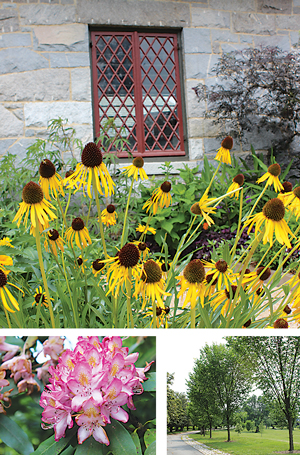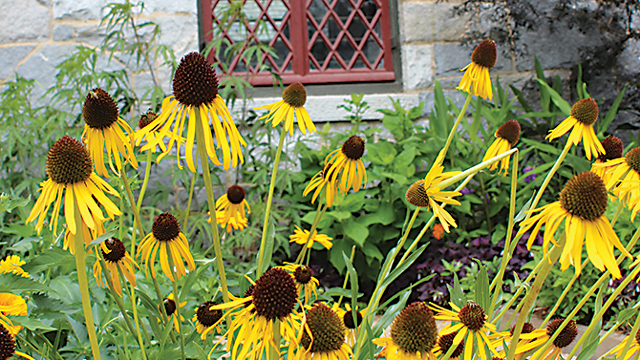Creating a garden that attracts pollinators is beneficial for the ecosystem and fun for families. Plus, few things are as rewarding as watching a butterfly light on a flower or a bumblebee lumber from blossom to blossom.
Pollinators require specific elements in the landscape to thrive. The basic needs are a source of water, food, nesting areas, and protection. Be aware that different pollinators have different needs. Some pollinators are plant-specific, such as monarch butterflies that require milkweed for an egg-laying surface. When the larvae hatch, the caterpillars ingest the alkaloid sap in the leaves offering them protection from predators for life. Other pollinators are less picky, such as bumblebees, native bees, and beetles. These visit many low-growing flowers in a bed, spreading pollen that sticks to their bodies or hair from flower to flower.
Size, shape, and color of the flowers, nectar production versus pollen availability, and nectar guides are all floral elements that add to the success of a pollinator garden. Native plants and pollinators have created a relationship over time. The plant needs the pollinators for fertilization for seed formation, and the pollinators need the plants for the nectar and pollen they produce as a food source. Some plants are pollinated by the wind, some by birds, and others are pollinated by crawling or flying insects. Some insects have adapted body parts, such as compartments in their hind legs, that enable pollen to be brought back to their nest or hive. Other pollinators, hummingbirds for example, need the high energy of the sugary nectar to survive. The sticky pollen a hummingbird picks up on its long bill is distributed as it flits from flower to flower.
In a pollinator garden, trees provide the upper story of a layered landscape, shrubs grow in the mid-section, and perennials and annuals make up the lower layer. Layers provide habitats for insects and birds, and create an ecosystem in which they can flourish. Consider the impact homeowners would have on the present environment if every homeowner would look at their landscape as an ecosystem. By inserting native plants into landscapes, homeowners could reestablish communities that span from Maine to Florida. This green corridor would invigorate the populations of insects, butterflies, birds, and other pollinators along the East Coast.
 To provide pollen or nectar for pollinators, your layered landscape must bloom all season long. One of the first plants to bloom each spring is the elm tree, typically in late February or early March. The native American elm tree (Ulmus americana) is making a comeback in the landscape with varieties such as ‘Jefferson’ and ‘Princeton’ that are highly resistant to Dutch elm disease. Because it adapts to a wide range of soil types and conditions, the tree is easy to grow. The roots grow down into the soil profile, rather than across the ground surface, allowing grass to grow underneath, and the tree has a vase-shaped growth habit that provides dappled shade in the landscape. The wood is sinewy and strong, resisting high winds from our southern storms.
To provide pollen or nectar for pollinators, your layered landscape must bloom all season long. One of the first plants to bloom each spring is the elm tree, typically in late February or early March. The native American elm tree (Ulmus americana) is making a comeback in the landscape with varieties such as ‘Jefferson’ and ‘Princeton’ that are highly resistant to Dutch elm disease. Because it adapts to a wide range of soil types and conditions, the tree is easy to grow. The roots grow down into the soil profile, rather than across the ground surface, allowing grass to grow underneath, and the tree has a vase-shaped growth habit that provides dappled shade in the landscape. The wood is sinewy and strong, resisting high winds from our southern storms.
A shrub to consider including in a pollinator garden is the native early summer blooming roseum rosebay rhododendron (Rhododendron maximum). Rhododendrons grow well in the acidic soil of Central Virginia, and they thrive in soil rich in compost and organic matter. It’s important to protect these plants from the midday summer sun by planting them on the east or north sides of the house, or in an area where the morning sun or late day sun falls upon them. Mulch or leaf litter keeps the roots cool and helps retain soil moisture. The bell or funnel-shaped flowers of the rhododendron have spots and splotches that are used by various bees and insects as nectar guides, serving as a kind of map as to where the nectar can be found within.
Coneflower (Echinacea sp.) is a perennial that blooms all summer, providing a cone-shaped seed head many goldfinches use as a food source in the late summer and fall. The flat flowers are appealing to butterflies and to various bees. It’s best to group these plants, rather than spread them across a garden space, to provide a strong show of color and attract pollinators. Coneflower will bloom in full sun or partial shade. Remember that full sun is defined as a solid six hours or more of sunshine striking the plant. Anything less is partial shade to full shade. Purple coneflower (Echinacea purpurea) is native to the Mid-Atlantic area while yellow coneflower (Echinacea paradoxa) is native to the Midwest. Coneflowers are very rich in pollen and nectar, which means butterflies, moths, and bees love them. Hummingbirds enjoy coneflowers, too, for the numerous insects they attract that provide these high-energy birds with protein.
Similar to how we might dress for unpredictable weather, when you’re planning your home’s landscaping, think layers. With a few thoughtful additions, any garden can benefit the populations of our pollinators and provide a source of natural entertainment and education for families.





